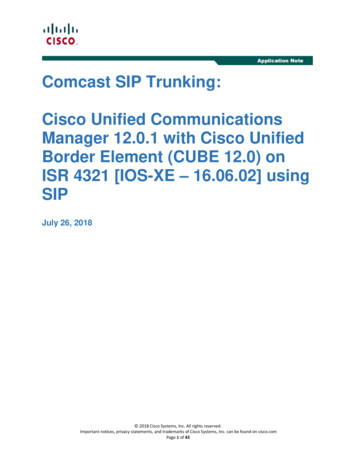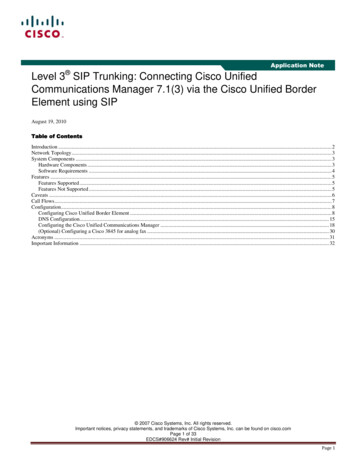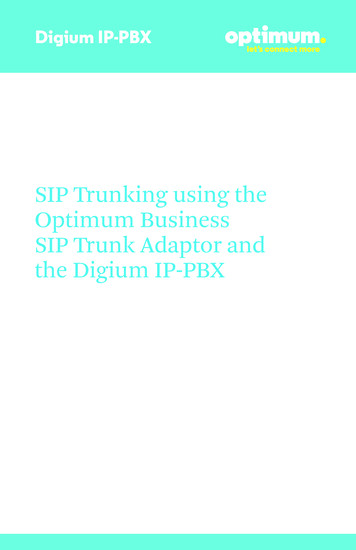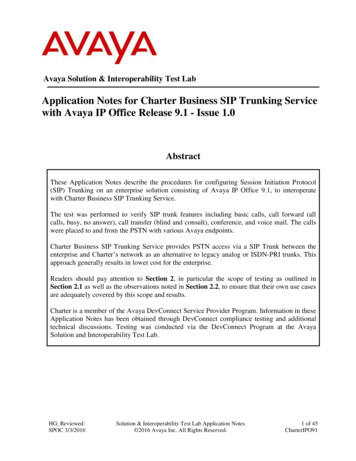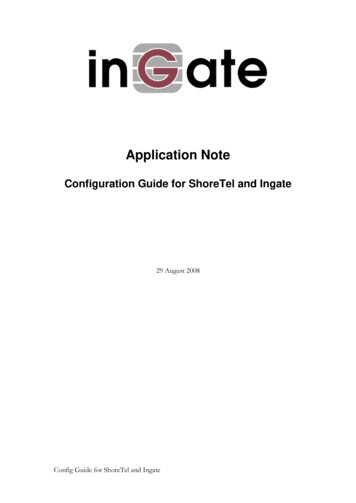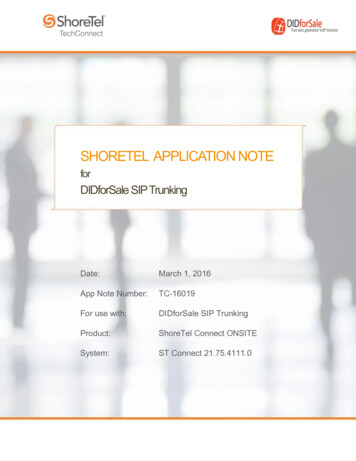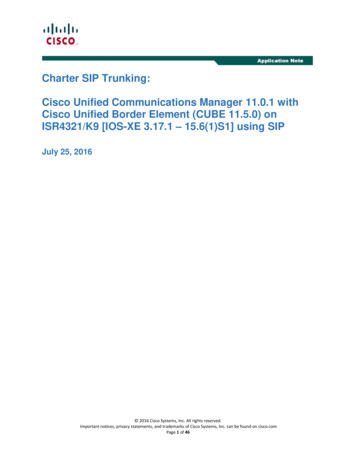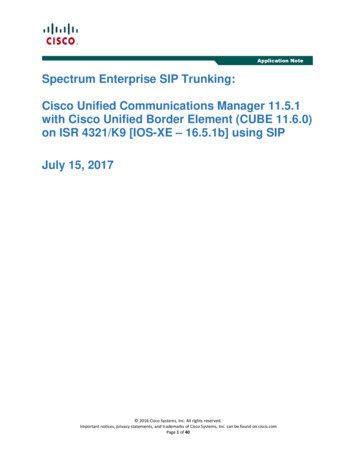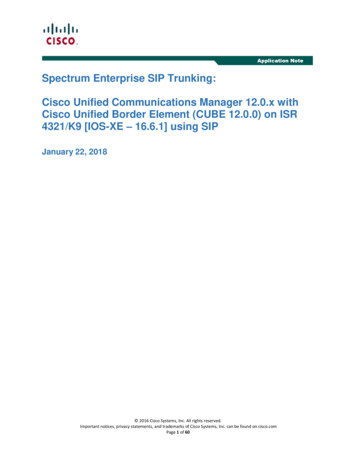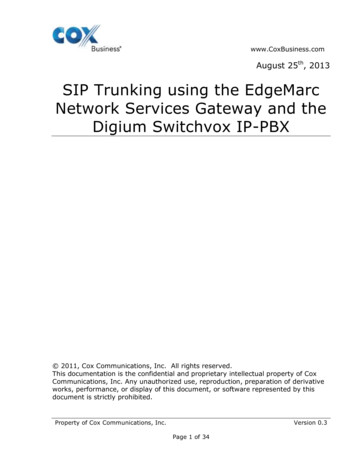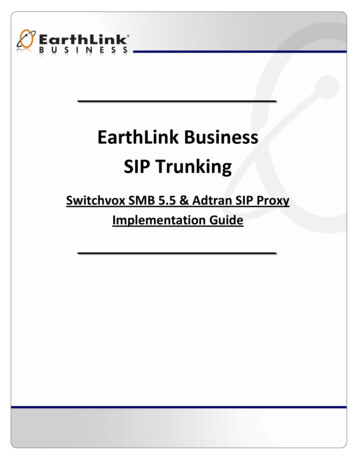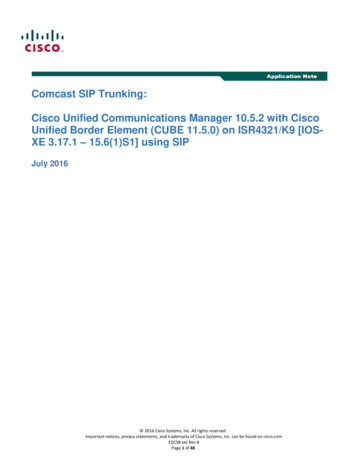
Transcription
Application NoteComcast SIP Trunking:Cisco Unified Communications Manager 10.5.2 with CiscoUnified Border Element (CUBE 11.5.0) on ISR4321/K9 [IOSXE 3.17.1 – 15.6(1)S1] using SIPJuly 2016 2016 Cisco Systems, Inc. All rights reserved.Important notices, privacy statements, and trademarks of Cisco Systems, Inc. can be found on cisco.comEDCS# xxx Rev #Page 1 of 48
Table of ContentsIntroduction . 4Network Topology . 5System Components . 6Hardware Requirements . 6Software Requirements . 6Features . 7Features Supported . 7Features Not Supported . 7Caveats . 7Configuration . 8Configuring the Cisco Unified Border Element. 8Network interface . 8Global Cisco UBE settings . 9Codecs . 10Dial peer . 10Call flow . 13Configuration example . 15Configuring Cisco Unified Communications Manager . 31Cisco UCM Version . 31Cisco Call manager Service Parameters . 31Offnet Calls via Comcast SIP Trunk . 31Dial Plan . 40Acronyms . 45Important Information . 46 2016 Cisco Systems, Inc. All rights reserved.Important notices, privacy statements, and trademarks of Cisco Systems, Inc. can be found on cisco.comEDCS# xxx Rev #Page 2 of 48
Table of FiguresFigure 1 Network Topology . 5Figure 2: Cisco UBE High Availability . 5Figure 3: Outbound Voice Call. 13Figure 4: Outbound Fax Call . 13Figure 5: Inbound Voice Call . 14Figure 6 : Inbound Fax Call . 14Figure 7 : PBX to PBX via Comcast Call . 14Figure 8: Cisco UCM Version . 31Figure 9: Service Parameters . 31Figure 10: SIP Trunk Security Profile . 32Figure 11: SIP Profile . 33Figure 12: SIP Profile (Cont.) . 34Figure 13: SIP Profile (Cont.) . 35Figure 14: SIP Trunks List . 36Figure 15: SIP Trunk to Cisco UBE . 37Figure 16: SIP Trunk to Cisco UBE (Cont.) . 38Figure 17: SIP Trunk to Cisco UBE (Cont.) . 39Figure 18: Route Patterns List . 40Figure 19: Route Pattern for Voice . 41Figure 20: Route Pattern for Voice (Cont.) . 42Figure 21: Route Pattern for Fax . 43 2016 Cisco Systems, Inc. All rights reserved.Important notices, privacy statements, and trademarks of Cisco Systems, Inc. can be found on cisco.comEDCS# xxx Rev #Page 3 of 48
IntroductionService Providers today, such as Comcast, are offering alternative methods to connect to the PSTN viatheir IP network. Most of these services utilize SIP as the primary signaling method and centralized IP toTDM POP gateways to provide on-net and off-net services.Comcast is a service provider offering that allows connection to the PSTN and may offer the end customera viable alternative to traditional PSTN connectivity. A demarcation device between these services andcustomer owned services is recommended. As an intermediary device between Cisco UnifiedCommunications Manager and Comcast network, Cisco Unified Border Element (Cisco UBE) ISR 4321/K9running IOS-XE 3.17 – 15.6(1)S1 can be used. The Cisco Unified Border Element provides demarcation,security, interworking and session control services for Cisco Unified Communications Manager 10.5.2connected to Comcast IP network.This document assumes the reader is knowledgeable with the terminology and configuration of CiscoUnified Communications Manager. Only configuration settings specifically required for Comcastinteroperability are presented. Feature configuration and most importantly the dial plan are customerspecific and need individual approach. This application note describes how to configure Cisco Unified Communications Manager (CiscoUCM) 10.5.2, and Cisco Unified Border Element (Cisco UBE) on ISR 4321/K9 [IOS-XE 3.17 15.6(1)S1] for connectivity to Comcast SIP Trunking service. The deployment model covered in thisapplication note is CPE (Cisco Unified Communications Manager 10.5.2) to PSTN (Comcast). Testing was performed in accordance to Comcast generic SIP Trunking test methodology and amongfeatures verified were – basic calls, DTMF transport, Music on Hold (MOH), unattended and attendedtransfers, call forward, conferences and interoperability with Cisco Unity Connection (CUC). The Cisco UCM configuration detailed in this document is based on a lab environment with a simpledial-plan used to ensure proper interoperability between Comcast SIP network and Cisco UnifiedCommunications. The configuration described in this document details the important configurationsettings to have enabled for interoperability to be successful and care must be taken by the networkadministrator deploying Cisco UCM to interoperate to Comcast SIP Trunking network.This application note does not cover the use of Calling Search Spaces (CSS) or partitions on Cisco UCM.To understand and learn how to apply CSS and partitions refer to the cisco.com link below:http://www.cisco.com/c/en/us/td/docs/voice ip comm/cucm/srnd/collab10/collab10/dialplan.html 2016 Cisco Systems, Inc. All rights reserved.Important notices, privacy statements, and trademarks of Cisco Systems, Inc. can be found on cisco.comEDCS# xxx Rev #Page 4 of 48
Network TopologyFigure 1 Network TopologyFigure 2: Cisco UBE High Availability 2016 Cisco Systems, Inc. All rights reserved.Important notices, privacy statements, and trademarks of Cisco Systems, Inc. can be found on cisco.comEDCS# xxx Rev #Page 5 of 48
System ComponentsHardware Requirements Cisco UCS-C240-M3S VMWare host running ESXi 5.5 StandardCisco ISR 4321/K9 router as CUBECisco ISR4321/K9 (1RU) processor with 1647061K/6147K bytes of memory with 3 Gigabit EthernetinterfacesProcessor board ID FLM1925W0X2Cisco 2851 Fax GatewayIP phones 7965 (SIP) and 7975 (SCCP)Comcast(Adtran) ESG – Provided and managed by ComcastSoftware Requirements Cisco Unified Communications Manager 10.5.2.13900-12Cisco Unity Connection 11.0.1.21900-11IOS-XE 3.17.1 – 15.6(1)S for ISR 4321/K9 Cisco Unified Border ElementCisco IOS Software, ISR Software (X86 64 LINUX IOSD-UNIVERSALK9-M), Version 15.6(1)S1,RELEASE SOFTWARE (fc3)Cisco IOS XE Software, Version 03.17.01.SIOS 15.0(1)XA for Cisco 2851 Fax GatewayComcast(Adtran) ESG R11.4.3.V – Provided and managed by Comcast 2016 Cisco Systems, Inc. All rights reserved.Important notices, privacy statements, and trademarks of Cisco Systems, Inc. can be found on cisco.comEDCS# xxx Rev #Page 6 of 48
FeaturesFeatures Supported Incoming and outgoing off-net calls using G711ULAWCall holdCall transfer (unattended and attended )Call ConferenceCall forward (all, busy, no answer)Calling Line (number) Identification Presentation (CLIP)Calling Line (number) Identification Restriction (CLIR)DTMF relay (both directions) (RFC2833)Media flow-through on Cisco UBEFax (G711 passthrough)Features Not Supported Cisco IP phones used in this test do not support Blind TransferFax (T.38) is not supported by Service ProviderIn HA Redundancy mode the Primary cube will not take over the Primary/Active role after areboot/network outageCaveats Caller ID is not updated after attended or semi-attended transfers to off-net phones. This is due to alimitation on Cisco UBE and will be resolved in the next release. The issue does not impact thecalls.For testing, 911 calls were routed internally in the Comcast lab 2016 Cisco Systems, Inc. All rights reserved.Important notices, privacy statements, and trademarks of Cisco Systems, Inc. can be found on cisco.comEDCS# xxx Rev #Page 7 of 48
ConfigurationConfiguring the Cisco Unified Border ElementNetwork interfaceConfigure Ethernet IP address and sub interface. The IP address and VLAN encapsulation used are forillustration only, the actual IP address can vary. For SIP trunks two IP addresses must be configured—LANand WAN.interface GigabitEthernet0/0/0description MS4 1/0/9ip address 10.64.4.155 255.255.0.0media-type rj45negotiation autoredundancy rii 11redundancy group 2 ip 10.64.4.157 exclusive!interface GigabitEthernet0/0/1description MS4 1/0/10ip address 10.70.24.6 255.255.255.0negotiation autoredundancy rii 12redundancy group 2 ip 10.70.24.8 exclusive! 2016 Cisco Systems, Inc. All rights reserved.Important notices, privacy statements, and trademarks of Cisco Systems, Inc. can be found on cisco.comEDCS# xxx Rev #Page 8 of 48
Global Cisco UBE settingsIn order to enable Cisco UBE IP2IP gateway functionality, enter the following:!voice service voipno ip address trusted authenticateaddress-hidingmode border-element license capacity 20allow-connections sip to sipredundancy-group 2fax protocol pass-through g711ulawsiprel1xx supported "rel100"session refreshasserted-id paiprivacy pstnearly-offer forcedmidcall-signaling passthrug729 ections sip to sipAllow IP2IP connections between two SIP call legsfax protocolSpecifies the fax protocolasserted-idSpecifies the type of privacy header in the outgoing SIP requestsand response messagesearly-offer forcedEnables SIP Delayed-Offer to Early-Offer globallymidcall-signaling passthruPasses SIP messages from one IP leg to another IP leg 2016 Cisco Systems, Inc. All rights reserved.Important notices, privacy statements, and trademarks of Cisco Systems, Inc. can be found on cisco.comEDCS# xxx Rev #Page 9 of 48
CodecsG711ulaw is used as the preferred codec for this testing and changed the preferences according to the test plandescriptionvoice class codec 1codec preference 1 g711ulawcodec preference 2 g729r8Dial peerCisco UBE uses dial-peer to route the call based on the digit to route the call accordingly.dial-peer voice 100 voipdescription Outgoing call from PBX to PSTN - WAN sidehuntstopdestination-pattern .Tsession protocol sipv2session target sip-serversession transport udpvoice-class codec 1voice-class sip asserted-id paivoice-class sip profiles 101voice-class sip options-keepalivevoice-class sip bind control source-interface GigabitEthernet0/0/1voice-class sip bind media source-interface GigabitEthernet0/0/1dtmf-relay rtp-ntefax-relay ecm disablefax rate disablefax nsf 000000fax protocol pass-through g711ulawno vad! 2016 Cisco Systems, Inc. All rights reserved.Important notices, privacy statements, and trademarks of Cisco Systems, Inc. can be found on cisco.comEDCS# xxx Rev #Page 10 of 48
dial-peer voice 200 voipdescription Outgoing call to Comcast - LAN sidehuntstopsession protocol sipv2session transport udpincoming called-number .Tvoice-class codec 1voice-class sip asserted-id paivoice-class sip options-keepalivevoice-class sip bind control source-interface GigabitEthernet0/0/0voice-class sip bind media source-interface GigabitEthernet0/0/0dtmf-relay rtp-ntefax-relay ecm disablefax rate disablefax nsf 000000fax protocol pass-through g711ulawno vad!dial-peer voice 300 voipdescription Incoming call From PSTN - WAN sidehuntstopsession protocol sipv2session transport udpincoming called-number 856.voice-class codec 1voice-class sip asserted-id paivoice-class sip profiles 101voice-class sip options-keepalivevoice-class sip bind control source-interface GigabitEthernet0/0/1voice-class sip bind media source-interface GigabitEthernet0/0/1 2016 Cisco Systems, Inc. All rights reserved.Important notices, privacy statements, and trademarks of Cisco Systems, Inc. can be found on cisco.comEDCS# xxx Rev #Page 11 of 48
dtmf-relay rtp-ntefax-relay ecm disablefax rate disablefax nsf 000000fax protocol pass-through g711ulawno vad!dial-peer voice 400 voipdescription Inbound from PSTN to PBX - LAN sidehuntstopdestination-pattern 856.session protocol sipv2session target ipv4:10.64.4.111:5060session transport udpvoice-class codec 1voice-class sip asserted-id paivoice-class sip options-keepalivevoice-class sip bind control source-interface GigabitEthernet0/0/0voice-class sip bind media source-interface GigabitEthernet0/0/0dtmf-relay rtp-ntefax-relay ecm disablefax rate disablefax nsf 000000fax protocol pass-through g711ulawno vad! 2016 Cisco Systems, Inc. All rights reserved.Important notices, privacy statements, and trademarks of Cisco Systems, Inc. can be found on cisco.comEDCS# xxx Rev #Page 12 of 48
Call flowIn the sample configuration presented here, Cisco UCM is provisioned with four-digit directory numberscorresponding to the last four DID digits. No digit manipulation is performed on the Cisco UBE.For incoming PSTN calls, the Cisco UBE presents the full ten-digit DID number to Cisco UCM. The CiscoUCM picks up the last 4 significant Digits configured under SIP Trunk and routes the call based on those 4digits. Voice calls are routed to IP phones; Fax calls are routed via a 4-digit route pattern over a SIP trunkthat terminates on the Fax Gateway and in turn to the VentaFax client connected to the Fax Gateway.CPE callers make outbound PSTN calls by dialing a “9” prefix followed by the destination number. Foroutbound fax calls from the analog fax endpoint, Cisco fax Gateway sends to Cisco UCM the DID withleading access code “9”. A “9.@” route pattern strips the prefix and routes the call with the remaining digitsvia a SIP trunk terminating on the Cisco UBE for Voice call or Fax. For PBX to PBX via Comcast, Callerdial 9 prefix followed by the target 1 10-digits number, 9 was stripped and the remaining digits were sendto Cisco UBE, Cisco UBE pass the DID under Dial Peer 100 and send to Comcast network which will directback to Cisco UBE and handled same as normal incoming PSTN call.Figure 3: Outbound Voice CallFigure 4: Outbound Fax Call 2016 Cisco Systems, Inc. All rights reserved.Important notices, privacy statements, and trademarks of Cisco Systems, Inc. can be found on cisco.comEDCS# xxx Rev #Page 13 of 48
Figure 5: Inbound Voice CallFigure 6 : Inbound Fax CallFigure 7 : PBX to PBX via Comcast Call 2016 Cisco Systems, Inc. All rights reserved.Important notices, privacy statements, and trademarks of Cisco Systems, Inc. can be found on cisco.comEDCS# xxx Rev #Page 14 of 48
Configuration exampleThe following configuration snippet contains a sample configuration of Cisco Unified Border Element withall parameters mentioned previously.Active Cisco UBEComcastCube1#sh ru
15.6(1)S1] for connectivity to Comcast SIP Trunking service. The deployment model covered in this application note is CPE (Cisco Unified Communications Manager 10.5.2) to PSTN (Comcast). Testing was performed in accordance to Comcast generic SIP Trunking test methodology and among
